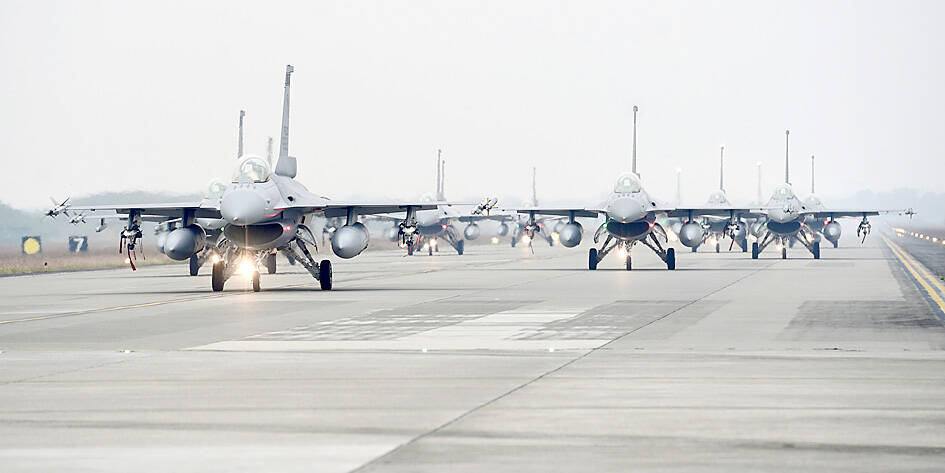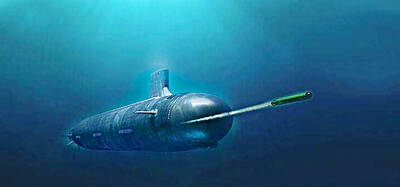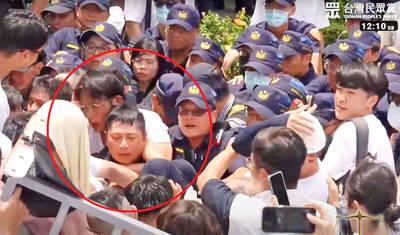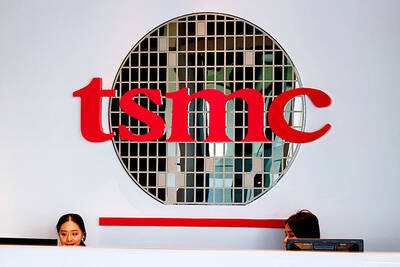Runways at seven airports are to be widened to make them more resilient to a potential missile attack from China, a source from the Ministry of National Defense said yesterday.
Ministry officials and US advisers made the decision after reviewing data from Han Kuang military exercises, the source said, adding that runways would be widened to 60m.
The adjustment would allow runways to more quickly be repaired so that fighter jets could take off and land, and would make the runways usable by B-52 bombers and large transport aircraft, the source said.

Photo: Lo Pei-de, Taipei Times
In a combat scenario, China would likely target Taiwan’s air bases, so the ministry is preparing by widening runways and performing annual repair drills, the source said.
The runway of the Ching Chuan Kang (清泉崗) Air Base in Taichung, which was originally built with the assistance of the US military, is 60m wide, as it was built to accommodate B-52 bombers. It was decided that runways at Taiwan’s other bases, which are 45m to 50m in width, should be widened to match that of Ching Chuan Kang, the source said.
“If runways are hit by surface-to-surface missiles or other weapons during wartime, takeoff and landing operations might be paralyzed — so we need to be prepared for that,” the source said.
Assuming that a runway is struck by Chinese ballistic missiles with an accuracy of less than 50m and a destruction radius of 25m, six missiles would give China an 80 percent chance of destroying the runway, the source said.
Potentially, China could destroy a runway with two missiles fired in short succession at a target with a radius of 100m, the source said.
“It’s not guaranteed that China would hit its target, but we must be ready to restore a runway should it be hit, and widening runways is the best way to accomplish that,” the source said.
The main runways of air bases have shoulders and buffer zones about 7.5m to 15m in width, which could be quickly reinforced by widening them, the source said.
Air force personnel have undergone runway repair training in the US, as well as at Ching Chuan Kang, the source said.
“During the last drill, the army’s unexploded ordinance disposal team used 18kg of TNT to blast holes in the base’s taxiway, simulating an enemy attack,” the source said. “The blast created a 2m-deep hole with a radius of 20m that teams used for the drill, which involved removing foreign objects, laying fiberglass repair kits, backfilling the crater and compacting it.”
During the drill, a minimum operating strip with a length of 1.5km and a width of 15m was opened to allow the resumption of aircraft takeoffs and landings in the shortest possible time, the source said.
Air force personnel have shortened runway repair times from four hours for one or large crater repair operations, down to 2.5 hours, the source said.

FIREPOWER: On top of the torpedoes, the military would procure Kestrel II anti-tank weapons systems to replace aging license-produced M72 LAW launchers Taiwan is to receive US-made Mark 48 torpedoes and training simulators over the next three years, following delays that hampered the navy’s operational readiness, the Ministry of National Defense’s latest budget proposal showed. The navy next year would acquire four training simulator systems for the torpedoes and take receipt of 14 torpedoes in 2027 and 10 torpedoes in 2028, the ministry said in its budget for the next fiscal year. The torpedoes would almost certainly be utilized in the navy’s two upgraded Chien Lung-class submarines and the indigenously developed Hai Kun, should the attack sub successfully reach operational status. US President Donald Trump

TPP RALLY: The clashes occurred near the Chiang Kai-shek Memorial Hall on Saturday at a rally to mark the anniversary of a raid on former TPP chairman Ko Wen-je People who clashed with police at a Taiwan People’s Party (TPP) rally in Taipei on Saturday would be referred to prosecutors for investigation, said the Ministry of the Interior, which oversees the National Police Agency. Taipei police had collected evidence of obstruction of public officials and coercion by “disorderly” demonstrators, as well as contraventions of the Assembly and Parade Act (集會遊行法), the ministry said in a statement on Sunday. It added that amid the “severe pushing and jostling” by some demonstrators, eight police officers were injured, including one who was sent to hospital after losing consciousness, allegedly due to heat stroke. The Taipei

NO LIVERPOOL TRIP: Taiwan’s Lin Yu-ting, who won a gold medal in the boxing at the Paris Olympics, was embroiled in controversy about her gender at that event Taiwanese boxer Lin Yu-ting (林郁婷) will not attend this year’s World Boxing Championships in Liverpool, England, due to a lack of response regarding her sex tests from the organizer, World Boxing. The national boxing association on Monday said that it had submitted all required tests to World Boxing, but had not received a response as of Monday, the departure day for the championships. It said the decision for Lin to skip the championships was made to protect its athletes, ensuring they would not travel to the UK without a guarantee of participation. Lin, who won a gold medal in the women’s 57kg boxing

The US has revoked Taiwan Semiconductor Manufacturing Co’s (TSMC, 台積電) authorization to freely ship essential gear to its main Chinese chipmaking base, potentially curtailing its production capabilities at that older-generation facility. American officials recently informed TSMC of their decision to end the Taiwanese chipmaker’s so-called validated end user (VEU) status for its Nanjing site. The action mirrors steps the US took to revoke VEU designations for China facilities owned by Samsung Electronics Co and SK Hynix Inc. The waivers are set to expire in about four months. “TSMC has received notification from the US Government that our VEU authorization for TSMC Nanjing